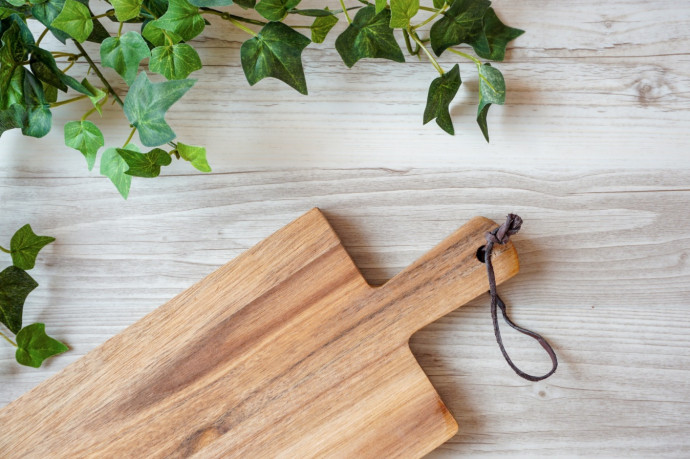Eco-cleaning Tips for Kitchen Cutting Boards

There are lots of products to keep our kitchen clean. There are all-purpose cleaners, special cleaners for ovens and drains, antibacterial products, and dishwashing detergents, to name a few. These products are designed to keep our kitchens safe and clean, but many of them contain alarming toxins which should not be used anywhere near food. Fortunately, there are some natural and safer alternatives that will help you tackle the toughest cleaning jobs. Today let’s focus on cutting boards eco cleaning. Enjoy!
1. Cutting boards
It is important to keep cutting boards clean, especially if you cut raw meat or fish on them. Ideally, you should have one board for raw meat and fish preparation and another for different foods, such as vegetables, cheese, and bread. You might prefer to buy a small board for cutting meat and fish which can be totally submerged in a bowl of hot, soapy water.
2. V is for vegetables
If you do not have two boards, then mark one of the sides “V” for vegetables and the other side “M” for meat. Prepare raw vegetables first, on the side marked “V” then flip the board over to prepare meat. Once you have finished preparing your meal, sanitize both sides of the board.
3. Materials used for cutting boards
Most cutting boards are made from wood or plastic. Some are made from acrylic, silicone, or glass, but these are usually countertop protectors and are not meant for prolonged use as cutting boards. There are good and bad points about each material.
Wooden cutting boards: wooden boards are usually heavier than plastic ones, will last for decades if well looked after, and have natural antibacterial qualities. Wooden boards can be FSC certified, which means they are from sustainably managed forests and biodegradable at the end of their lives. Wooden boards need seasoning before their first use and regular re-oiling to keep them sealed against bacteria. They cannot be submerged in water because they can crack as they dry out, so must not be put into a dishwasher.
Plastic cutting boards: plastic is lighter to maneuver around the kitchen, cheap to buy or replace, and can be placed in a hot dishwasher to kill germs. However, it scratches easily and germs can multiply in these scratches if not properly sanitized. Plastic cutting boards do not degrade and are made from a non-renewable resource. Some plastic cutting boards are impregnated with antibacterial ingredients which can be harmful to people and the environment. See Antibacterial cleaners on page 48 for more information.
Glass boards: these are easy to keep hygienic and sanitized as they can be put in the dishwasher or submerged in boiling water. Glass boards are not really designed for a lot of cutting—they are meant more as countertop protectors, but occasional cutting will not damage them. Glass boards blunt knives easily and there is the risk of breaking them if you drop one.
5. How to season a wooden cutting board
You will need to oil a new wooden board around five times to get it seasoned and ready for use. This will prevent staining, mold growth, and absorption of odors and bacteria. After that, maintain the integrity of your board with a once-monthly application of oil. Do not use vegetable oils as these go rancid. Instead, use coconut oil or a food-grade mineral oil specifically intended for use with unseasoned wood. Before applying the oil, pour a little in a cup and warm it by placing the cup over a bowl of hot water. Apply with a soft cloth and allow to soak in for four to six hours before wiping away any excess oil. Repeat this five times over the course of a few days. It is worth investing in the best cutting board you can afford. Pine cutting boards tend to be quite soft, so they dent and scratch easily. A solid hardwood board, such as one made from oak or ash, may cost more but will last you a lifetime.
7. How to keep your cutting board hygienic
Whichever type of cutting board you choose, ensure it is kept clean and washed after each use to prevent the spreading of bacteria such as E. coli and salmonella. Scrub your cutting board well with hot, soapy water after each use and dry it thoroughly. Bacteria need a moist environment and can only survive a few hours without moisture. If you are preparing a meal that contains meat, if you’d prefer, wash your cutting board in between preparing raw meat and any other parts of your meal, such as the vegetables. If you’d prefer, prepare vegetables first, and cut the meat last.
8. Ways to sanitize your cutting board
Lemons and limes: wipe over your board with the cut side of a fresh lemon or lime. Alternatively, squeeze fresh lemon or lime juice over the board, leave for a few minutes, then wipe with a damp cloth.
Salt: use salt like a scouring powder to remove odors, clean, and disinfect your boards. You can even pour some salt over the cut end of a lemon to make your very own scouring “sponge!” Allow the salt to remain in contact with the board for around 10 minutes before rinsing off with very hot water. This solution will remove odors such as garlic, lemon, or fish. Note that regular salting can dry out wooden boards, so you may need to re-oil them more regularly.
Hot water: fit a non-wooden cutting board into a bowl, pour boiling water over it, leave until you can handle it, then dry well.
White vinegar: vinegar has deodorizing properties. Keep a spray bottle of neat white vinegar for spraying on your boards after washing. Follow with a spray of hydrogen peroxide at 3 percent strength.
